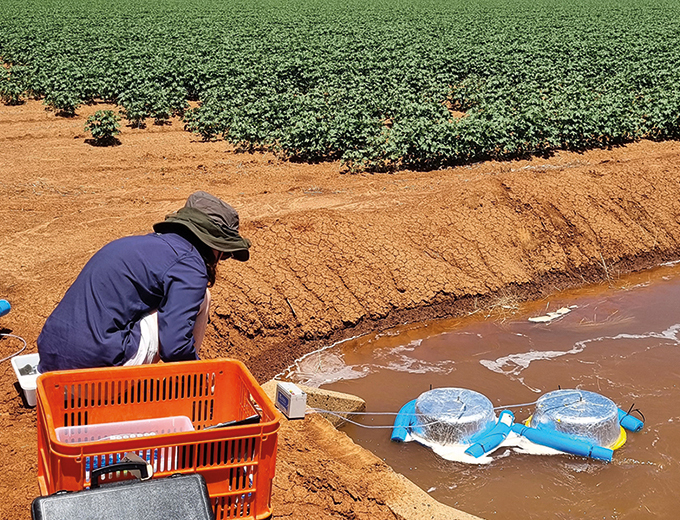Looking to water for emissions reductions
Researchers are looking at optimising irrigation performance in bankless channel cotton layouts to improve water management, optimise nitrogen use efficiency and measure greenhouse gas emissions from water delivery systems.

Irrigation performance influences the efficiency of fertiliser uptake by plants by affecting the uniformity of water both across the field and at depth; and consequently the scheduling of fertiliser to the crop.
Researchers from the Centre for Regional and Rural Futures at Deakin University, Dr Wendy Quayle and Dr Jackie Webb, say that since on average about a third of applied nitrogen (N) is lost in conventional growing systems (costing the industry approximately $32 million each year), there is opportunity to reduce these losses and improve N recovery through linking fertiliser application and watering schedules.
By developing datasets, the researchers hope to assist the development of integrated irrigation and N technology in different designs of bankless surface irrigation layouts.
“Reducing up-front costs, increasing flexibility, and technology advances are encouraging growers to install bankless systems for labour, water and energy efficiency,” Wendy said.
“Despite bankless channel irrigation systems becoming more widely adopted, there’s currently no specific information available for growers that discusses the overall efficiency of N applied using these new layouts.
“Our research plans to change this.”
The project, which began in 2022, will use existing commercial bankless systems on farms in the Murrumbidgee region (Wiradjuri country) and in Northern NSW (Kamilaroi country) for the study.
Nitrogen fertiliser use efficiency (NUE) will be a primary focus through understanding the effect of layout and irrigation water dynamics. The project will consider linking farm decisions of water-run urea and ground application to automated irrigation scheduling driven by soil moisture sensing. New, controlled-release fertiliser N products will be tested at irrigation bay scale, and N measurements in tailwater will be measured to compare runoff nitrogen losses in different layouts.
Jackie says they also aim to measure greenhouse gas (GHG) emissions from on-farm irrigation channels, tail water and the bankless channel area during a field trial as part of this project.
“These are essentially the uncropped areas on the farm that don’t get accounted for in farm GHG budgets, so we are looking to fill a gap here,” Jackie said.
“The International Panel on Climate Change (IPCC) provides emission factors to help calculate nitrous oxide and methane emissions from these on-farm irrigation areas but they are based on global averages which are not representative of our semi-arid temperate climates of irrigation farms in Australia.
“Cotton industry researcher Dr Graeme Schwenke of NSW DPI conducted a laboratory study on cotton channel sediments and found they could be hotspots for N2O emissions during irrigation cycles.
“We essentially want to test this in the field and specifically during urea-run irrigation, as there are a lot of unknowns on how much dissolved urea makes it to the crop during channel transport.”
The project is still in its infancy and more measurements will be undertaken this coming field season.
“Jackie undertook some preliminary pilot investigations last season and we are considering options around methodologies specifically for on-farm channels and bankless channels and what we might be able to do in coming seasons,” Wendy said.
“This research is exciting as it will provide better definition of water-nitrogen options in new bankless layouts including the on-farm fate of N surface run off and GHG emissions.”
For more
Dr Wendy Quayle
Dr Jackie Webb
This article appears courtesy of the Cotton Research and Development Corporation (CRDC). It was published in the (Spring 2023) edition of CRDC’s Spotlight magazine: www.crdc.com.au/spotlight
